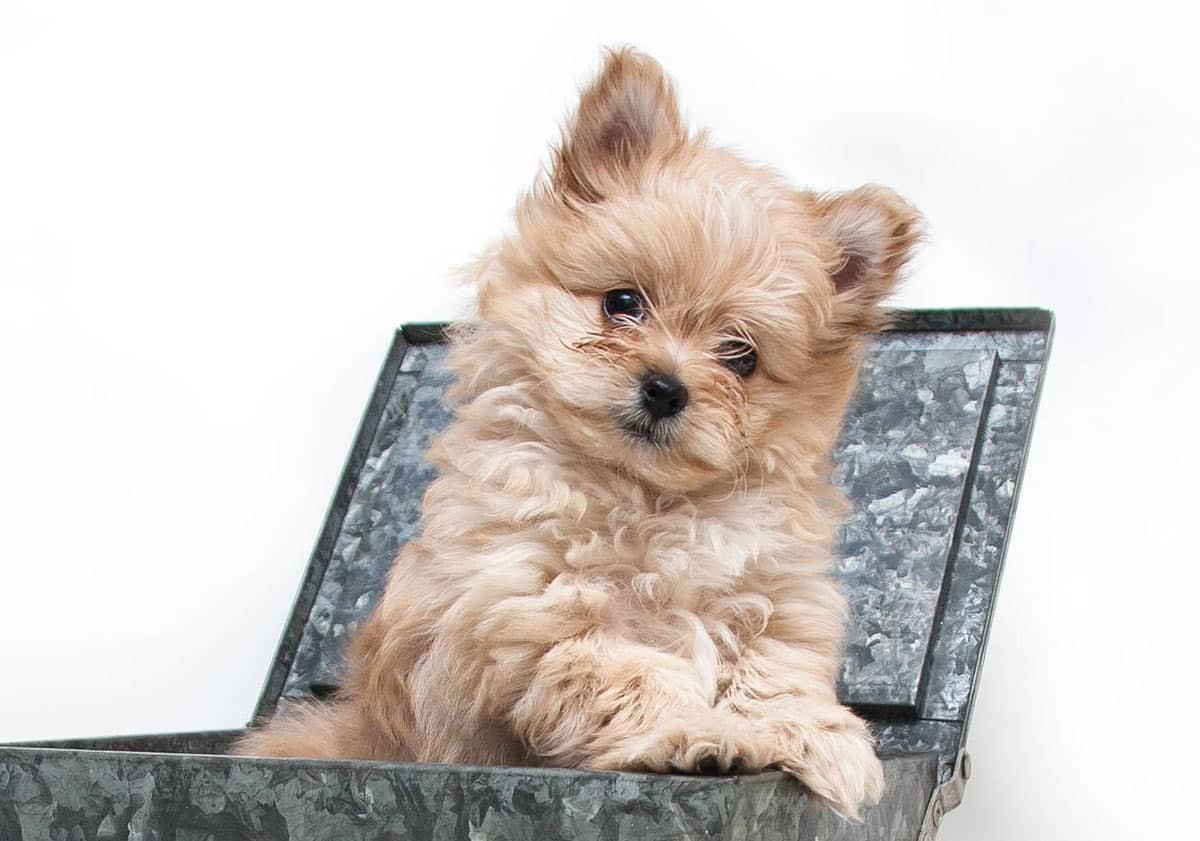Have a question about our Pomapoo puppies?
"*" indicates required fields
overview of the Pomapoo Dog Breed
Are you looking for a small, sweet-yet-lively companion?
Check out our Pomapoo puppies for sale below!
Weighing between 5 and 15 pounds, Pomapoos are an excellent size for small homes and apartments! They are intelligent, affectionate, and playful companions. They also are very alert and make great watchdogs.
Adopt your Pomapoo puppy today and start enjoying a happy, affectionate friend!
You can also browse our other available breeds if you are looking for something different.
Pomapoo temperament
Lively: Pomapoos are active, inquisitive, and love to play with humans. Poodles and Pomeranians are both playful breeds. They do well with children, but caution needs to be taken due to their small size.
Intelligent: Pomapoos get their intelligence from the Poodle. They are bright and can be taught most things quickly and easily. Your Pomapoo will love learning tricks and playing games.
Sensitive: Some Pomapoos can be sensitive to changes in their environment or to their owners’ emotions. They may pick up on moods and respond accordingly.
Adaptable: Pomapoos are often adaptable to different living situations. They can do well in apartments or houses with yards, as long as they receive the appropriate amount of exercise.
Bold: Pomapoos are confident and bold. They may be small, but they don’t let that fact get in the way; they are small dogs with big personalities!
Great Watchdogs: Pomapoos are very alert and sensitive to new surroundings or unusual events. They have a loud bark and will let you know if something is not right.
Apartment-Friendly: Weighing only 5-15 pounds, the Pomapoo is a nice size for small homes and apartments.
It’s important to remember that each individual Pomapoo can vary in personality based on genetics, upbringing, and socialization. Spending time with the puppy’s parents if possible and providing consistent training, socialization, and care will help ensure a well-rounded and happy Pomapoo companion.
Pomapoo Breed history
The Pomapoo originated in North America in the 1990s when breeders began mixing Pomeranians and Toy Poodles to create a designer breed.
To dig deeper into the Pomapoo’s history, let’s look at the history of their parents.
The History of the Poodle
Although Poodles are the national dog of France, they originated in Germany, where they were bred and used as retrieving water dogs.
With its elegance and intelligence, the Poodle became a popular breed among the French nobles and in other parts of Europe. Because of their trainable, attention-loving nature and showy looks, Poodles were often used in the circus. They have also been used for hunting truffles- underground mushrooms- with their long snouts.
The Standard Poodle was downsized to the Miniature Poodle. The Toy Poodle was first bred in America in the early 20th century. Today, Toy Poodles rank number 7 out of all dogs registered with AKC.
The History of the Pomeranian
The Pomeranian originates in a region of Northern Europe called Pomerania.
Originally, they were larger sled dogs. But today, Pomeranians are the smallest of the Spitz breeds.
Queen Victoria from England is credited with making the Pomeranian breed famous. While visiting Europe in 1888, she saw a Pomeranian dog and fell in love with it. After bringing one back to England with her, the popularity of the breed significantly increased.
Queen Victoria was a serious breeder of Pomeranians and showed them at dog shows. She is also credited with reducing the Pomeranian from about 30 pounds to the toy size we have today.
It is said that favorite Pomeranian, Turi, was present at Queen Victoria’s bedside when she died in 1901.
Pomeranians were also loved by Marie Antoinette, Emile Zola, and Wolfgang Amadeus Mozart.
The United States fell in love with Pomeranian soon after England did and were accepted into the AKC registry in 1888.
Today, Pomeranians rank number 23 out of all dog breeds registered with AKC.
Pomapoo Average size
Pomapoos are 8-10 inches tall at the shoulder and weigh 5-15 pounds.
Average Pomapoo lifespan
Pomapoos usually live for 12-14 years.
Pomapoo body features
Pomapoos can be a solid color or a mix of colors, including brown, black, white, red, fawn, and sable. Their fur can be straight and fluffy like a Pomeranian or curly or wavy like a Poodle.
Both Poodles and Pomeranians change colors from puppyhood to adulthood. If you are looking for a specific color, ask your breeder for advice on predicting the color of your dog.
Pomapoos usually have dark eyes and a dark nose. Their ears can be pointed and erect like a Pomeranian or hang down on the sides of their face like a Poodle.
grooming Your Pomapoo Puppy
Pompapoos can have coats that favor the Poodle or the Pomeranian, or they can be a combination of both. Talk to your vet about specific care for your Pomapoo.
Poodle Coat Care
Although Poodles are known for minimal shedding, their curly coats still need some extra care. They need to be groomed every 4-6 weeks and brushed regularly, or their coat will become matted and tangled. You can take your Pomapoo to the groomer or learn to give them a haircut by yourself.
Pomeranian Coat Care
Pomeranians have a full, lush, coat and it requires more care than some breeds. Thankfully, the dog’s small size makes grooming relatively easy.
You’ll need to brush them daily with a pin brush and weekly with a slicker brush. Pomeranians need a full groom every 4-6 weeks. This includes bath, brushing, ears, nails, and anal glands.
Your Pomapoo will also need its nails trimmed, and teeth brushed regularly.
Keeping Your Pomapoo Puppy Healthy
Pomapoos are generally a healthy breed, but all dog owners need to be aware of conditions that may affect their dog.
Conditions That May Affect Your Pomapoo:
Hip and Elbow Dysplasia
Like all dog breeds, they are at risk for hip and elbow dysplasia, two of the most common health issues in dogs. Hip and elbow dysplasia occurs when the thigh bone doesn’t fit snugly into the hip and can result in limping, lameness, or arthritis if it’s not addressed.
Hip and elbow dysplasia can be genetic, or it can be caused by environmental factors such as overeating or injuries.
Here are some ways to prevent hip dysplasia in your puppy:
- Ask the breeder for an OFA (Orthopedic Foundation for Animals) Hip Clearance. Dogs with hip dysplasia shouldn’t be bred.
- Talk to your vet about the right food for your puppy and stick to the correct amount to prevent unhealthy growth.
- Keep your puppy from running or jumping excessively on hard surfaces and from standing on their hind legs.
Protecting Your Pomapoo from Obesity
You can protect your dog from one of the most common health problems: obesity. One of the best ways to extend your dog’s life is by feeding them the correct amount of food and giving them adequate exercise.
Typical Pomapoo Allergens
First of all, what causes allergies?
Allergens are caused by dander, which is dead skin cells. Both animals and humans shed these dead skin cells. Dander is attached to the fur that dogs shed.
Your Pomapoo puppy may inherit the Pomeranian’s coat or the Poodle’s coat, or they may be a combination of both!
Pomeranians have thick double coats and are medium shedders most of the year and heavy shedders during seasonal shedding. However, they are small dogs, and shedding can be controlled with daily brushing and frequent bathing.
Poodles are one of the lowest shedding dogs breeds, and many people with allergies can tolerate a poodle.
Each puppy has a different combination of genes, so allergens vary from dog to dog. Spending time with a puppy before adopting them is a good way to know if you are triggered by their allergens.
- 1. Will my Pomapoo attack other dogs?Pomapoos are pretty chill and normally don’t take a strong dislike to other dogs. However, they don’t always remember how tiny they are, and if provoked, they’ll take on dogs twice their size. In general, you shouldn’t have to worry about your Pomapoo scrapping with every dog they meet at the dog park.
- 2. Will my Pomapoo be friends with my kids?Personality-wise, Pomapoos get along well with children. However, they are tiny, fragile animals, and they could easily be injured if they are dangled by a leg, roughly dressed up in too-small doll clothes, or over-hugged. All that to say, it’s very important to teach your kids to play gently with your Pomapoo. As long as your kids are old enough and responsible enough not to hurt your puppy, all will be well.
- 3. Will my Pomapoo bark my ears off?Dogs are similar to humans – some are chatty, and some are quieter. How vocal your Pomapoo is depends on his personality and upbringing. However, this breed tends toward the more vocal end of the spectrum. They’ll bark to alert you of anything new, inside or outside the house, or to let you know they want your attention. If you get a real chatterbox of a pup, you may have to do some training to teach him to mind his tongue.
- 4. Will my Pomapoo protect me?Your Pomapoo will certainly give you a heads-up if there’s anything resembling danger in the vicinity. But when it comes to actual protection, don’t expect too much from these dogs. They are tiny and could be crushed with a boot. They make much better watch dogs than actual guard dogs.
- 5. How much energy do Pomapoos have?Pomapoos have a surprising amount of energy for such a tiny package. They love to play and will soak up any interaction you give them. However, in terms of exercise, these little guys don’t require too much, despite their moderate-high energy levels. One walk per day or a good run-around in the yard should suffice.
- 6. Will my Pomapoo get along with my friends when they come to visit me?That depends. Most Pomapoos love people and will make friends with all visitors to your home. But if they take more after their Pomeranian parents, they may be a bit more reserved with strangers. At any rate, you shouldn’t have to worry about your Pomapoo ever actually getting aggressive with strangers, especially if she’s been well-socialized as a puppy.
- 7. Will I have to spend multiple hours a day grooming my Pomapoo?It’s hard to predict how a Pomapoo’s coat will turn out because they are a mixed breed. In general, they are middle-of-the-road-difficult to groom. They do require regular brushing and the occasional trip to the groomer, but neither will you be spending multiple hours a day grooming them.
- 8. Will I tear my hair out trying to train my Pomapoo? Are they stubborn?Most dogs have a bit of a stubborn streak. Pomapoos are no exception. How stubborn your dog is depends on his individual personality. However, Pomapoos are highly intelligent, and with a little time and effort they can learn anything you want to teach them. It will take time and commitment, but you likely won’t tear your hair out.
- 9. Can a Pomapoo be an outside dog?Pomapoos were meant to be companion dogs, and they love socializing with their people. We do not recommend keeping them outdoors or in a solitary environment where they don’t get any social interaction. That would cause them to become lonely and depressed.
- 10. Will a Pomapoo eat my canary and terrorize my guinea pig?All dogs like to chase and eat small, fluffy things like canaries and guinea pigs. Pomapoos are no exception – you’ll probably want to introduce your Pomapoo to your canary and make sure she knows that little Tweety is NOT FOOD. That said, Pomapoos tend to get along well with other pets, such as cats and other dogs, and they may not pose as large a threat to your other pets as some dogs with higher prey drives.







